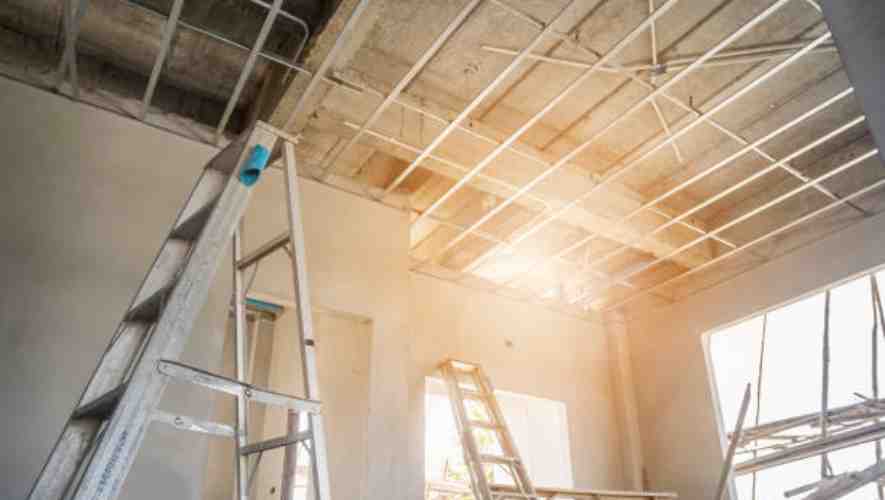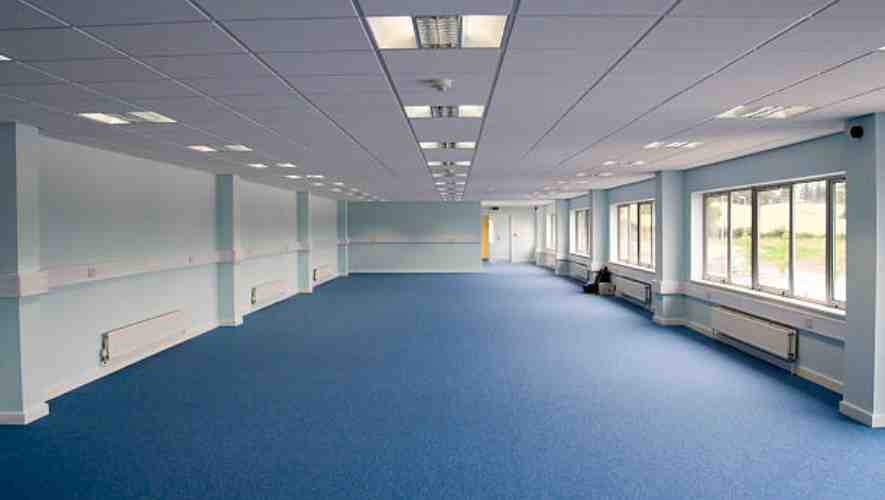Are you pondering over how to add that personal touch to your living space without leaving permanent marks? The desire to hang decorations, plants, or lighting from the ceiling without drilling is a common challenge, for renters or those who prefer not to commit to a permanent change. Drilling can be daunting; it’s permanent, requires tools, and not to mention, it’s a no-go in most rental agreements. But, your creative vision doesn’t have to be compromised.
How To Hang From Ceiling Without Drilling? Finding a solution to hang items from your ceiling without drilling can be quite a puzzle. But fret not, as there are numerous innovative and secure methods. Whether it’s using adhesive hooks, suction cups, or tension rods, these alternatives promise a sturdy hold without the permanence of drilling.
The subsequent paragraphs will guide you through several ingenious solutions that will respect the integrity of your ceiling while allowing you to personalize your space to your heart’s content. We’ll explore options that cater to different weights and types of décor, ensuring you find the perfect match for your needs. So, get ready to transform your space with confidence and a touch of creativity!
Understanding Ceiling Structures

Understanding Ceiling Structures involves a detailed exploration of various ceiling materials and the challenges associated with drilling into these materials. Below, each subheading addresses a specific material, discussing its characteristics and the potential issues with drilling.
Drywall is a common ceiling material, prized for its smooth finish and ease of installation. Made from gypsum board, it’s lightweight yet relatively sturdy.Drilling into drywall requires precision.
Overdrilling can cause cracks or compromise the structural integrity, while insufficient support can lead to the fixture’s collapse. It’s vital to locate studs or joists for secure anchoring.
Concrete ceilings are known for their durability and fire resistance. They’re often found in commercial buildings or modern homes. Drilling into concrete requires specialized equipment, like hammer drills and masonry bits.
The process is noisy and creates a lot of dust. Moreover, drilling can risk damaging embedded electrical conduits or rebar, potentially weakening the structure.
Tile ceilings, often made from materials like ceramic or metal, offer aesthetic variety and ease of maintenance.Drilling through tiles is tricky. It demands steady hands and appropriate drill bits to avoid cracking or chipping.
For ceramic tiles, diamond-tipped drill bits are preferable. The backing material also influences the drilling method; for instance, a metal-backed tile requires different tools compared to wood-backed ones.
Wooden beam ceilings, whether exposed or part of a structure, add a rustic or traditional charm. Wood is generally easier to drill into compared to concrete or tile, but the type of wood (hardwood or softwood) dictates the drill bit and technique.
Drilling must be done carefully to avoid splitting the wood, and it’s crucial to consider the weight load that the drilled area will bear.
Metal ceilings, often used for their sleek, modern look and durability, pose unique challenges. They require specific drill bits,cobalt or titanium, to penetrate without damaging the material.
Drilling into metal can create sharp edges and may require lubrication to reduce friction. It’s also important to consider the potential for rusting or weakening of the material around the drill hole.
Safety Considerations

When it comes to hanging objects from the ceiling, safety must be the foremost concern. Incorrectly hung items can pose serious risks, including property damage and personal injury.
To mitigate these dangers, it is essential to understand the weight limitations of both the hanging hardware and the ceiling structure.
Utilizing appropriate anchors and supports designed for ceiling installation is crucial. Regular inspection and maintenance of these installations also play a vital role in ensuring ongoing safety.
Assessing the Environment
Before any installation, assessing the environment is crucial. This involves examining the ceiling type, whether it’s drywall, plaster, or concrete, as each material requires different hanging methods and hardware.
Awareness of any underlying electrical wiring or plumbing is also essential to avoid accidents. The location of the object should not interfere with daily activities or obstruct emergency exits and should comply with local building codes and regulations.
Choosing the Right Hardware
Selecting the right hardware is critical for the safe hanging of objects. This includes understanding the weight capacity of hooks, chains, or cables used. For heavy items, it’s advisable to use hardware that distributes weight across multiple ceiling joists.
Always prefer quality-certified hardware and avoid makeshift solutions, as they significantly increase the risk of accidents.
Installation Techniques
Proper installation techniques are paramount for safety. This may require professional assistance,for heavy or large objects.
The technique involves ensuring that the object is level, securely fastened, and not prone to swaying or movement, which could weaken the installation over time.
For installations in public spaces or workplaces, adhering to Occupational Safety and Health Administration (OSHA) guidelines is necessary.
Regular Maintenance and Inspection
Regular maintenance and inspection are essential for long-term safety. This includes checking for any signs of wear and tear, loose fittings, or corrosion in the hardware.
For public buildings or workplaces, keeping a documented schedule of inspections and maintenance work can be beneficial.
Being aware of any changes in the environment, such as added humidity or temperature fluctuations, which can affect certain materials, is important for proactive safety management.
Alternative Hanging Methods

Adhesive Hooks
Adhesive hooks offer a simple and tool-free solution for hanging items. They work by adhering to surfaces through a sticky backing, usually made of strong, double-sided tape.
These hooks are perfect for renters or anyone looking to avoid drilling holes. When it comes to weight capacity, adhesive hooks can vary greatly. Some are designed for lightweight items like keys and small frames, while others can hold heavier objects like large pictures or small planters. It’s crucial to check the weight rating before use and to use them on suitable surfaces, like smooth, clean walls, to ensure optimal performance.
Tension Rods
Tension rods are an innovative way to utilize ceiling space for hanging without permanent fixtures. These rods work by creating outward pressure between two surfaces,walls or within a window frame, and can be extended to the ceiling with special attachments.
They are ideal for lightweight applications, like hanging plants or light fabrics.Their weight capacity is limited, and overloading them can cause them to collapse. It’s important to follow manufacturer guidelines and use them in appropriate settings to ensure stability and safety.
Magnetic Solutions
Magnetic systems provide a unique and effective way to hang items from metal ceilings. These systems use strong magnets that attach directly to the metal surface, eliminating the need for drilling or adhesives.
They are particularly useful in spaces with metal ceiling beams or panels. The strength of the magnetic solution is a key factor, as it determines the weight it can safely hold. They are ideal for hanging light fixtures, decorative elements, or even tools in a workshop setting.
To ensure safety and effectiveness, it’s important to select magnets that are appropriately rated for the weight of the item being hung
Introduction to Hanging Methods
When considering ways to hang items without causing damage, adhesive hooks, tension rods, and magnetic solutions are popular options.
Each method offers a unique approach to hanging objects, balancing ease of installation with minimal impact on surfaces. This guide will walk you through the steps for each method, ensuring stability and minimizing the risk of damage.
Adhesive Hooks: A Damage-Free Solution
Step-by-Step Installation
Surface Preparation
Clean the surface with rubbing alcohol to remove any grease or dirt. Dry thoroughly.
Positioning
Decide the exact spot for the hook. Avoid placing it on wallpapers or delicate surfaces.
Adhesive Application
Peel off the backing and press the hook firmly against the surface for 30 seconds.
Waiting Period
Wait for at least an hour before hanging anything on the hook to ensure a strong bond.
Usage Tips
Avoid overloading the hook and periodically check its adhesion to prevent accidental falls.
Ensuring Stability and Avoiding Damage
Regularly inspect the hook for signs of weakening. If repositioning, gently remove it using a hairdryer to soften the adhesive, reducing the risk of surface damage.
Tension Rods: Versatile and Easy
Step-by-Step Installation
Measurement: Measure the space where the rod will be placed to choose the correct size.
Adjusting Length: Extend the rod to the desired length,a bit longer than the measured width.
Securing the Rod
Place the rod in the desired location and twist it to tighten and secure it in place.
Testing Stability
Gently pull on the rod to ensure it is securely held by the tension.
Usage Tips
Regularly check the tension and avoid hanging overly heavy items to maintain stability.
Ensuring Stability and Avoiding Damage
Periodically retighten the rod to prevent slipping. Use rubber ends to protect surfaces and ensure a firmer grip.
Magnetic Solutions: Innovative and Secure
Step-by-Step Installation
Choosing Magnets
Select magnets strong enough to hold your items, considering the surface type.
Surface Cleaning
Clean the surface and the magnet to ensure a strong bond.
Positioning
Place the magnet in the desired location, ensuring it aligns with the item to be hung.
Attachment
Attach the item to the magnet, checking for a secure hold.
Usage Tips
Regularly check the magnet’s strength and ensure it’s not causing any surface discoloration.
Ensuring Stability and Avoiding Damage
Avoid sliding the magnets as this can scratch surfaces. Instead, lift and reposition them if necessary.
Maintenance and Long-Term Care

Introduction to Hanging Method Maintenance
When it comes to maintaining hanging methods, whether it be for artwork, signage, or fixtures, a proactive approach is essential.
Regular maintenance not only ensures the longevity of the hanging method but also guarantees the safety and integrity of the displayed items. Understanding the basics of routine checks and care is the first step towards effective long-term preservation.
Routine Inspection Schedules
Establishing a routine inspection schedule is pivotal in changing method maintenance. This involves periodic checks to assess the stability and condition of both the hanging hardware and the item being displayed.
Regular inspections, ideally every three to six months, can help identify potential issues before they escalate into major problems, thereby extending the lifespan of your hanging method.
Identifying Signs of Wear and Tear
Awareness of the common signs of wear and tear forms a critical part of hanging method maintenance. Look for rusting in metal components, fraying in ropes or wires, and cracks or chips in any supporting structures.
Early detection of these signs can prevent failures, ensuring that your items remain securely in place and reducing the risk of damage.
Environmental Considerations
The environment plays a significant role in the maintenance of hanging methods. Factors such as humidity, temperature fluctuations, and exposure to sunlight can affect different materials differently.
Regularly assess the environmental conditions and adjust your maintenance routine accordingly to combat any detrimental effects these factors might have.
Replacement and Upgrading
Knowing when to replace parts of your hanging system is as important as regular maintenance. If inspection reveals significant wear or damage, it’s crucial to replace the affected parts immediately.
Staying informed about advancements in hanging technology can offer opportunities to upgrade to more durable and efficient systems, enhancing the overall safety and appearance of your display.
Conclusion
In the quest to hang items from the ceiling without drilling, it’s evident that there are multiple innovative and reliable methods to choose from. Whether you opt for adhesive hooks, tension rods, or any other alternative, each offers a balance of strength and gentleness to your home’s structure.
While these methods offer a fantastic way to decorate without commitment, it’s essential to choose wisely based on the weight of the item and the surface of your ceiling. Remember, personalizing your space should be a fun, creative, and reversible process. With the solutions provided, you’re well-equipped to transform your living space into a reflection of your style and spirit, all without the need for drilling. So go ahead, let your imagination soar and your ceilings be drill-free!

